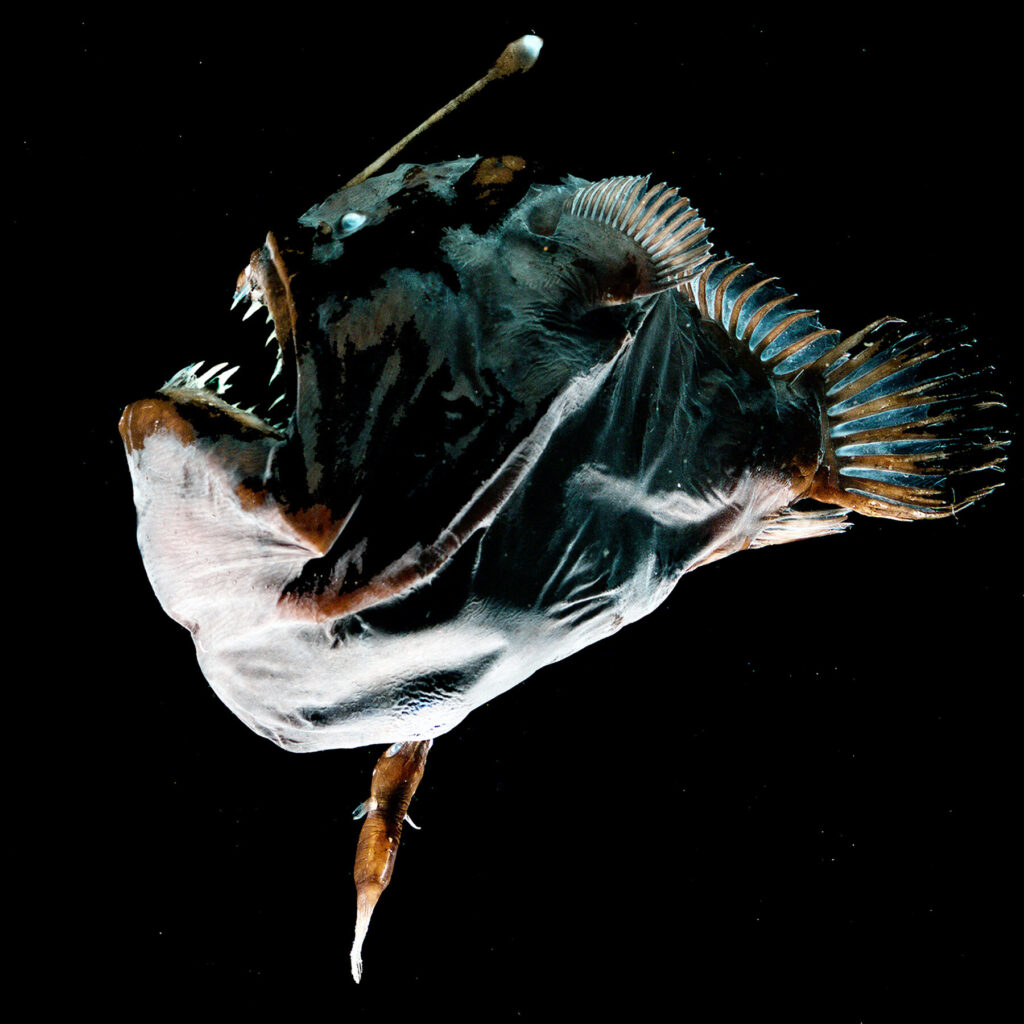
Image Source: :.american oceans
Picture a world cloaked in perpetual darkness, where the weight of the ocean presses down like a vice, and temperatures plunge to near freezing. In this realm of the ocean’s twilight zone resides a true master of deception: the Anglerfish. With its eerie bioluminescent lure, formidable teeth, and grotesque appearance, it has garnered a reputation as a fearsome predator of the deep. But is this perception entirely accurate? Let’s shine a light on the captivating world of the Anglerfish and unravel the truth from the myths.

Realm of the Deep: Where Anglerfish Reign
Anglerfish, members of the order Lophiiformes, inhabit the mesopelagic and bathypelagic zones, extending from 200 to 4,000 meters (650 to 13,100 feet) below the ocean’s surface. This vast expanse, perpetually cast in twilight, serves as the domain where these masters of adaptation thrive. With over 200 species, each showcasing unique sizes, colors, and lure formations, the diversity within the Anglerfish group is astounding.

Source: Rare-gallery.com
The hallmark of the Anglerfish lies in its bioluminescent lure—a fleshy appendage dangling from its head, emitting a mesmerizing red or green glow. This “esca” acts as a beacon in the darkness, luring unsuspecting prey closer, akin to moths drawn to a flame. What’s truly remarkable is the mimicry displayed by different species, with some lures resembling shrimp while others imitate fellow anglerfish, complete with their miniature lures! This sophisticated deception expands the Anglerfish’s hunting repertoire, ensuring a wider array of unsuspecting victims.
Yet, beneath this façade lies a formidable arsenal: rows of needle-like teeth poised to swallow prey whole. Their gaping mouths and flexible jaws create a trap larger than their own bodies. While this combination of bioluminescent allure and sharp weaponry paints a portrait of a ruthless predator, the reality is more nuanced.

Anglerfish picture

Anglerfish picture
Beyond Predation: Unveiling the Anglerfish’s Diet
Contrary to their menacing appearance, Anglerfish are not indiscriminate killers. Their dietary preferences encompass a surprising variety, including smaller fish, squid, crustaceans, and even bioluminescent organisms. Many species employ ambush tactics, using their lure to draw prey within striking range before launching a swift attack.

But their adaptability extends further. Some Anglerfish species exhibit scavenging behavior, feasting on organic matter descending from the surface waters. This opportunistic strategy ensures a diverse array of food sources in the resource-scarce depths of the ocean.
A Tale of Strange Love and Sacrifice: Anglerfish Reproduction
One of the most intriguing aspects of anglerfish biology is their unique approach to reproduction. In a realm where encounters are infrequent, male Anglerfish have adopted a peculiar strategy. Picture a minuscule male, dwarfed by the female, permanently fused to her body. He essentially becomes a reproductive appendage, supplying endless genetic material for her eggs.

#Anglerfish front view
This extreme form of sexual parasitism guarantees reproductive success in the vast, sparsely populated depths of the ocean. The female, often hundreds of times larger than her male counterparts, may harbor multiple fused males, ensuring fertilization for her vast clutch of eggs. This bizarre tale of affection and sacrifice underscores the extraordinary adaptations Anglerfish have evolved to surmount the challenges of their deep-sea habitat.

Beyond the Abyss: Threats and Conservation
Despite their formidable appearance, Anglerfish face threats of their own. Deep-sea fishing practices can inadvertently capture these creatures, while pollution and climate change pose potential hazards to their habitat. As our understanding of these fascinating creatures deepens, addressing these threats becomes imperative for their conservation.
More Than Mere Illusion: The Significance of Anglerfish
Anglerfish transcend their status as mere denizens of the deep. They embody adaptation, innovation, and resilience, playing pivotal roles as predators, scavengers, and prey within the deep-sea ecosystem. By studying them, we gain invaluable insights into the intricate workings of this enigmatic realm, illuminating its biodiversity and ecological equilibrium.

Fear often stems from ignorance. As we delve into the mysteries of the deep sea, creatures like the Anglerfish cease to be mere monsters and instead emerge as captivating examples of evolution and survival in one of Earth’s most challenging environments.












